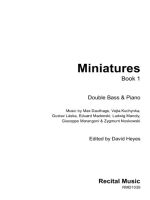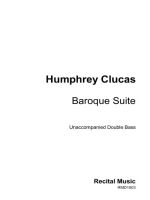Adventures in Wonderland

Product code:
£15.00
Description
This simple chamber work was originally written with several young children from my teaching studio in mind, as I wished for them to have some little pieces to play together. Each of the short movements attempts to depict with music one these remarkable characters of Lewis Carroll’s popular children’s book “Alice’s Adventures in Wonderland”:
Carroll has this to say concerning the White Rabbit, the first character Alice meets on her adventure: “Was he framed on the ‘Alice’ lines, or meant as a contrast? As a contrast, distinctly. For her ‘youth,’ ‘audacity,’ ‘vigour,’ and ‘swift directness of purpose,’ read ‘elderly,’ ‘timid,’ ‘feeble,’ and ‘nervously shilly-shallying,’ and you will get something of what I meant him to be. I think the White Rabbit should wear spectacles. I am sure his voice should quaver, and his knees quiver, and his whole air suggest a total inability to say “Bo” to a goose!”
To the Cheshire Cat Carroll has given the ability to disappear and reappear at will, often leaving only its toothy grin behind as it fades away. Alice’s initial conversation with this unusual creature unfolds thus: `Cheshire Puss,’ she began, rather timidly, `Would you tell me, please, which way I ought to go from here?’ `That depends a good deal on where you want to get to,’ said the Cat. `I don’t much care where–‘ said Alice. `Then it doesn’t matter which way you go,’ said the Cat. `–so long as I get SOMEWHERE,’ Alice added as an explanation. `Oh, you’re sure to do that,’ said the Cat, `if you only walk long enough.’
The Mad Hatter is first encountered in the story as Alice arrives at a tea party, where he is often seen making short, personal remarks, asking unanswerable riddles and reciting nonsensical poetry. At the tea party, the time is perpetually 6 o’clock because, as Hatter explains it, Time and the He “quarrelled last March at the great concert given by the Queen of Hearts, in which I had to sing. Well, I’d hardly finished the first verse,’ said the Hatter, `when the Queen jumped up and bawled out, “He’s murdering the time! Off with his head!” ‘And ever since that,’ the Hatter went on in a mournful tone, `he won’t do a thing I ask! It’s always six o’clock now.”
Carroll offers this description of his main character Alice: “Loving, first, loving and gentle: loving as a dog (forgive the prosaic simile, but I know no earthy love so pure and perfect), and gentle as a fawn; then courteous – courteous to all, high or low, grand or grotesque, King or Caterpillar, even as though she were herself a King’s daughter, and her clothing of wrought gold: then trustful, ready to accept the wildest impossibilities with all that utter trust that only dreamers know; and lastly, curious – wildly curious, and with the eager enjoyment of Life that comes only in the happy hours of childhood, when all is new and fair, and when Sin and Sorrow are but names – empty words signifying nothing!”
And finally, Carroll presents the following remarks about the Queen of Hearts: “I pictured to myself the Queen of Hearts as a sort of embodiment of ungovernable passion – a blind and aimless Fury. The Queen had only one way of settling all difficulties, great or small. ‘Off with his head!’ she said, without even looking round.”
Description
This simple chamber work was originally written with several young children from my teaching studio in mind, as I wished for them to have some little pieces to play together. Each of the short movements attempts to depict with music one these remarkable characters of Lewis Carroll’s popular children’s book “Alice’s Adventures in Wonderland”:
Carroll has this to say concerning the White Rabbit, the first character Alice meets on her adventure: “Was he framed on the ‘Alice’ lines, or meant as a contrast? As a contrast, distinctly. For her ‘youth,’ ‘audacity,’ ‘vigour,’ and ‘swift directness of purpose,’ read ‘elderly,’ ‘timid,’ ‘feeble,’ and ‘nervously shilly-shallying,’ and you will get something of what I meant him to be. I think the White Rabbit should wear spectacles. I am sure his voice should quaver, and his knees quiver, and his whole air suggest a total inability to say “Bo” to a goose!”
To the Cheshire Cat Carroll has given the ability to disappear and reappear at will, often leaving only its toothy grin behind as it fades away. Alice’s initial conversation with this unusual creature unfolds thus: `Cheshire Puss,’ she began, rather timidly, `Would you tell me, please, which way I ought to go from here?’ `That depends a good deal on where you want to get to,’ said the Cat. `I don’t much care where–‘ said Alice. `Then it doesn’t matter which way you go,’ said the Cat. `–so long as I get SOMEWHERE,’ Alice added as an explanation. `Oh, you’re sure to do that,’ said the Cat, `if you only walk long enough.’
The Mad Hatter is first encountered in the story as Alice arrives at a tea party, where he is often seen making short, personal remarks, asking unanswerable riddles and reciting nonsensical poetry. At the tea party, the time is perpetually 6 o’clock because, as Hatter explains it, Time and the He “quarrelled last March at the great concert given by the Queen of Hearts, in which I had to sing. Well, I’d hardly finished the first verse,’ said the Hatter, `when the Queen jumped up and bawled out, “He’s murdering the time! Off with his head!” ‘And ever since that,’ the Hatter went on in a mournful tone, `he won’t do a thing I ask! It’s always six o’clock now.”
Carroll offers this description of his main character Alice: “Loving, first, loving and gentle: loving as a dog (forgive the prosaic simile, but I know no earthy love so pure and perfect), and gentle as a fawn; then courteous – courteous to all, high or low, grand or grotesque, King or Caterpillar, even as though she were herself a King’s daughter, and her clothing of wrought gold: then trustful, ready to accept the wildest impossibilities with all that utter trust that only dreamers know; and lastly, curious – wildly curious, and with the eager enjoyment of Life that comes only in the happy hours of childhood, when all is new and fair, and when Sin and Sorrow are but names – empty words signifying nothing!”
And finally, Carroll presents the following remarks about the Queen of Hearts: “I pictured to myself the Queen of Hearts as a sort of embodiment of ungovernable passion – a blind and aimless Fury. The Queen had only one way of settling all difficulties, great or small. ‘Off with his head!’ she said, without even looking round.”



